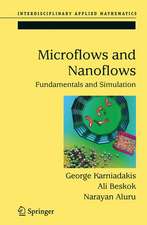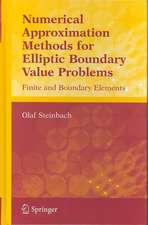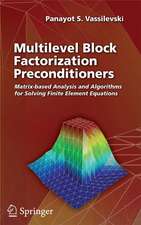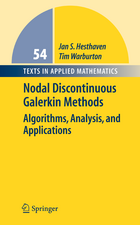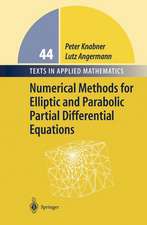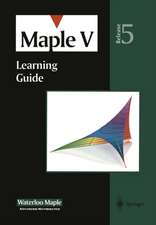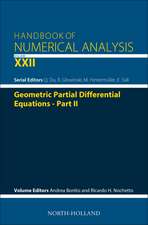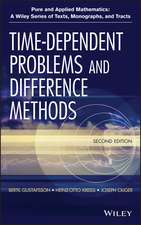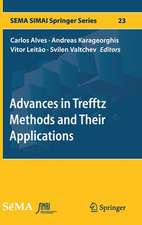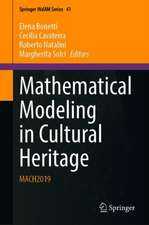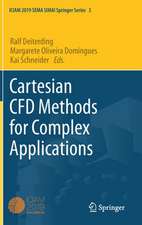Scientific Computing: A Historical Perspective: Texts in Computational Science and Engineering, cartea 17
Autor Bertil Gustafssonen Limba Engleză Hardback – 12 oct 2018
In turn, at the end of the Second World War scientific computing took a giant step forward with the advent of electronic computers, which greatly accelerated the development of numerical methods. As a result, scientific computing became established as a third scientific method in addition to the two traditional branches: theory and experimentation.
The book traces numerical methods’ journey back to their origins and to the people who invented them, while also briefly examining the development of electronic computers over the years. Featuring 163 references and more than 100 figures, many of them portraits or photos of key historical figures, the book provides a unique historical perspective on the general field of scientific computing – making it a valuable resource for all students and professionals interested in the history of numerical analysis and computing, and for a broader readership alike.
| Toate formatele și edițiile | Preț | Express |
|---|---|---|
| Paperback (1) | 389.70 lei 6-8 săpt. | |
| Springer International Publishing – 2 feb 2019 | 389.70 lei 6-8 săpt. | |
| Hardback (1) | 494.11 lei 6-8 săpt. | |
| Springer International Publishing – 12 oct 2018 | 494.11 lei 6-8 săpt. |
Din seria Texts in Computational Science and Engineering
- 15%
 Preț: 595.86 lei
Preț: 595.86 lei -
 Preț: 400.26 lei
Preț: 400.26 lei - 19%
 Preț: 544.68 lei
Preț: 544.68 lei - 4%
 Preț: 466.33 lei
Preț: 466.33 lei - 20%
 Preț: 325.00 lei
Preț: 325.00 lei - 20%
 Preț: 588.56 lei
Preț: 588.56 lei -
 Preț: 389.11 lei
Preț: 389.11 lei -
 Preț: 416.01 lei
Preț: 416.01 lei -
 Preț: 430.21 lei
Preț: 430.21 lei -
 Preț: 439.07 lei
Preț: 439.07 lei -
 Preț: 451.55 lei
Preț: 451.55 lei - 15%
 Preț: 608.08 lei
Preț: 608.08 lei -
 Preț: 394.87 lei
Preț: 394.87 lei -
 Preț: 393.90 lei
Preț: 393.90 lei -
 Preț: 387.75 lei
Preț: 387.75 lei -
 Preț: 504.50 lei
Preț: 504.50 lei -
 Preț: 396.62 lei
Preț: 396.62 lei -
 Preț: 482.45 lei
Preț: 482.45 lei - 20%
 Preț: 338.03 lei
Preț: 338.03 lei -
 Preț: 498.91 lei
Preț: 498.91 lei -
 Preț: 398.35 lei
Preț: 398.35 lei -
 Preț: 390.84 lei
Preț: 390.84 lei
Preț: 494.11 lei
Nou
Puncte Express: 741
Preț estimativ în valută:
94.55€ • 101.10$ • 78.83£
94.55€ • 101.10$ • 78.83£
Carte tipărită la comandă
Livrare economică 17 aprilie-01 mai
Preluare comenzi: 021 569.72.76
Specificații
ISBN-13: 9783319698465
ISBN-10: 331969846X
Pagini: 282
Ilustrații: XIII, 262 p. 84 illus., 31 illus. in color.
Dimensiuni: 155 x 235 x 22 mm
Greutate: 0.57 kg
Ediția:1st ed. 2018
Editura: Springer International Publishing
Colecția Springer
Seria Texts in Computational Science and Engineering
Locul publicării:Cham, Switzerland
ISBN-10: 331969846X
Pagini: 282
Ilustrații: XIII, 262 p. 84 illus., 31 illus. in color.
Dimensiuni: 155 x 235 x 22 mm
Greutate: 0.57 kg
Ediția:1st ed. 2018
Editura: Springer International Publishing
Colecția Springer
Seria Texts in Computational Science and Engineering
Locul publicării:Cham, Switzerland
Cuprins
1 Scientific Computing, an introduction.- 2 Computation far back in time.- 3 The centuries before computers.- 4 The beginning of the computer era.- 5 The establishment of scientific computing as a new discipline.- 6 Impact of numerical analysis and scientific computing.- References.
Recenzii
“The book evolves like a numerical course where the historical aspects are somewhat expanded at the expense of the numerical issues, but the main formulas and ideas are there. The numerics are however too thin to be useful as lecture notes for a course on numerical analysis. Therefore the book can only serve as additional literature to accompany a true course about the numerics.” (Adhemar Bultheel, European Mathematical Society, euro-math-soc.eu, March 20, 2019)
Notă biografică
Bertil Gustafsson is Professor at Uppsala University and a member of the Royal Swedish Academy of Sciences. His main area of research is the numerical solution of partial differential equations.
Earlier books:
B. Gustafsson, H.-O. Kreiss, J. Oliger: Time-Dependent Problems and Difference Methods, Whiley (1995).
B. Gustafsson: High Order Difference Methods for Time Dependent PDE. Springer (2008).
B.Gustafsson: Fundamentals of Scientific Computing. Springer (2011).
B. Gustafsson, H.-O. Kreiss, J. Oliger: Time-Dependent Problems and Difference Methods, 2nd ed., Whiley (2013).
Earlier books:
B. Gustafsson, H.-O. Kreiss, J. Oliger: Time-Dependent Problems and Difference Methods, Whiley (1995).
B. Gustafsson: High Order Difference Methods for Time Dependent PDE. Springer (2008).
B.Gustafsson: Fundamentals of Scientific Computing. Springer (2011).
B. Gustafsson, H.-O. Kreiss, J. Oliger: Time-Dependent Problems and Difference Methods, 2nd ed., Whiley (2013).
Textul de pe ultima copertă
This book explores the most significant computational methods and the history of their development. It begins with the earliest mathematical / numerical achievements made by the Babylonians and the Greeks, followed by the period beginning in the 16th century. For several centuries the main scientific challenge concerned the mechanics of planetary dynamics, and the book describes the basic numerical methods of that time.
In turn, at the end of the Second World War scientific computing took a giant step forward with the advent of electronic computers, which greatly accelerated the development of numerical methods. As a result, scientific computing became established as a third scientific method in addition to the two traditional branches: theory and experimentation.
The book traces numerical methods’ journey back to their origins and to the people who invented them, while also briefly examining the development of electronic computers over the years. Featuring 163 references and more than 100 figures, many of them portraits or photos of key historical figures, the book provides a unique historical perspective on the general field of scientific computing – making it a valuable resource for all students and professionals interested in the history of numerical analysis and computing, and for a broader readership alike.
In turn, at the end of the Second World War scientific computing took a giant step forward with the advent of electronic computers, which greatly accelerated the development of numerical methods. As a result, scientific computing became established as a third scientific method in addition to the two traditional branches: theory and experimentation.
The book traces numerical methods’ journey back to their origins and to the people who invented them, while also briefly examining the development of electronic computers over the years. Featuring 163 references and more than 100 figures, many of them portraits or photos of key historical figures, the book provides a unique historical perspective on the general field of scientific computing – making it a valuable resource for all students and professionals interested in the history of numerical analysis and computing, and for a broader readership alike.
Caracteristici
Survey of the historical development of the most important numerical methods and electronic computers covering the whole field of scientific computing Brief comments regarding the life of some of the key people Portraits or photos of many researchers having made important contributions to scientific computing

